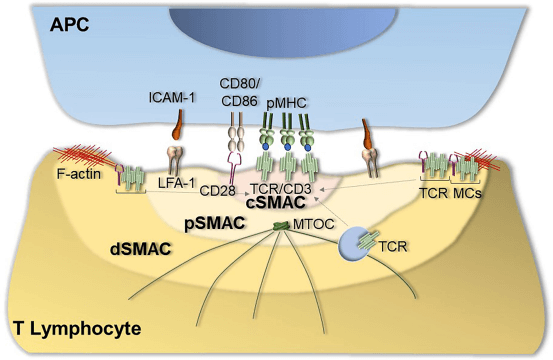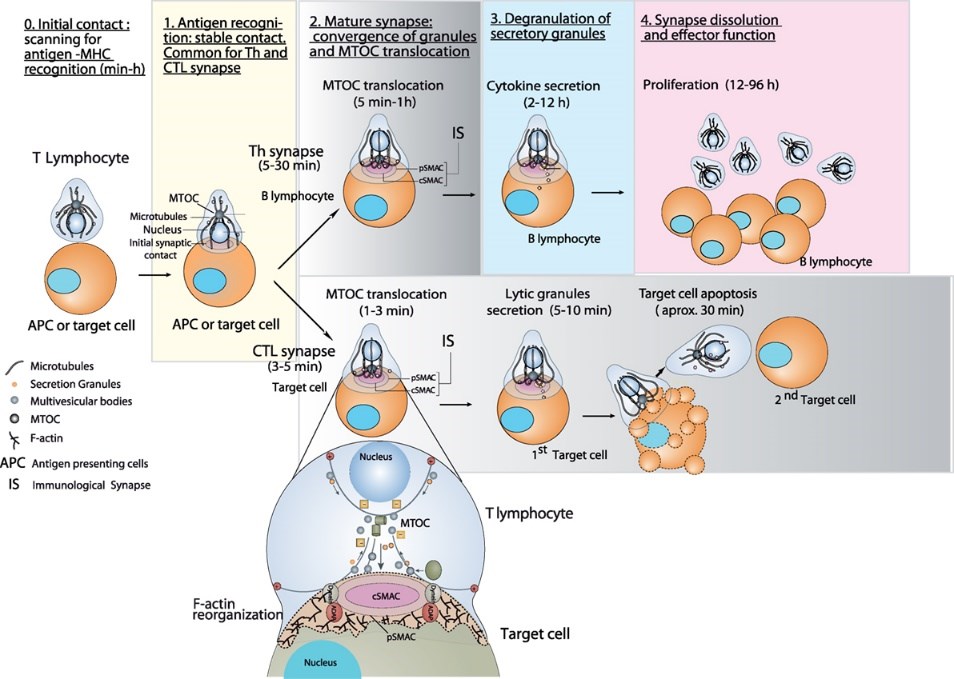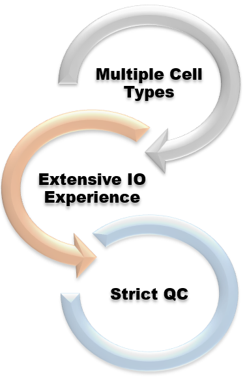Immune Synapse Formation Assay
Why do We Study Immune Synapse Formation?
The immunological synapse (IS) is a specialized intricate supramolecular activation cluster structure that arises at the interface between T cells and antigen-presenting cells. Its formation is an essential step in humoral immune responses, which supports the integrity of the contact between T cells and APC, and stimulates T-cell activation and proliferation. The establishment of an immune synapse formation assay platform is of the utmost importance for revealing the pathogenesis of disease and new drug development.
 Fig.1 Immunological synapse assembly.1
Fig.1 Immunological synapse assembly.1
How to Study Immune Synapse Formation?
Creative Biolabs provides high-quality immune synapse formation assay services to investigate IS formation and how various chemicals and therapies may influence it.
In our immune synapse formation assay, we provide a deeper look at the interaction between T cells and target cells to analyze the impact of test articles and the immunotherapies on the formation of the immune synapse through a cell culture model. T cells were pre-stimulated and then fluorescently labeled, while APC or target cells were pre-cultured, and then co-culture two cell types and add relevant test articles. Some special markers like LFA-1, ICAM-1, and Phalloidin were used to identify synapses, and DAPI nuclear staining was used to accurately count the total number of cells. The final detection parameters can be given by the imaging instrument. Throughout the process, factors such as treatment concentration, and incubation time, might influence the final results. Creative Biolabs optimizes the entire experiment based on the customer's project.
 Fig.2 Imaging secretory traffic polarization at immune synapses of living T lymphocytes. (Calvo, 2018)
Fig.2 Imaging secretory traffic polarization at immune synapses of living T lymphocytes. (Calvo, 2018)
Service Workflow
Creative Biolabs is dedicated to providing high-quality immune synapse formation assay services and delivering accurate reports to our customers.
How to Work: End-to-end Custom Service
Stage 1: Target Cell Culture and Labeling
- The first stage focuses on preparing the target cells for the assay. This involves culturing the specified cell lines, expanding them to an appropriate density, and then fluorescently labeling them so they can be easily visualized during the subsequent imaging steps.
Stage 2: Effector Cell Preparation and Co-culture Setup
- Next, the step involves getting the immune effector cells ready and initiating the interaction with the target cells. This includes preparing various effector cell types, such as Jurkat cells (both wild-type and customer-provided transduced versions), human primary T-cells, and human PBMCs, followed by combining them with the pre-labeled target cells to form co-cultures.
Stage 3: Test Articles Co-treatment
- This stage is the experimental manipulation of the co-cultures with test articles. In this stage, the formed immune synapse co-cultures are treated with test articles.
Stage 4: Immunostaining for Synapse Visualization
- This stage is the process of preparing the cells for microscopic analysis to identify and characterize immune synapses. This involves using detection antibodies (Customers can specify detection antibodies according to project conditions.) for primary staining to highlight key components of the synapse, along with DAPI counterstaining to visualize cell nuclei.
Stage 5: Image Acquisition and Data Analysis
- This is the final steps of capturing visual data and extracting meaningful quantitative information. High-resolution images are obtained using confocal microscopy, and then a specialized, customized image analysis pipeline is used to quantify various aspects of the immune synapses, such as their number, size, morphology, and marker colocalization, culminating in a comprehensive data report.
 Fig.3 Our immune synapse formation assay workflow. (Creative Biolabs)
Fig.3 Our immune synapse formation assay workflow. (Creative Biolabs)
Highlights of Our Services

Multiple cell types to empower our immune synapse formation assay service.
We have 200+ human tumor cell lines to choose from for immune synapse formation assay.
Extensive immune-oncology experience to empower immune synapse formation assay service.
We have experienced immunologists to help carry out relevant experimental projects in the immune-oncology field.
Standardized and strict quality control to achieve high reliability of data
We follow strict standards from experimental design, and experimental procedures, to final data processing to achieve reliable service quality.
Representative Data
1. The immune synapses reveal the CD8 T cells' aberrant functions during chronic HIV infection
 Fig.4 Diverse synaptic interfaces established from Human polyclonal CD8 T cells with lipid bilayers. (Anikeeva, 2022)
Fig.4 Diverse synaptic interfaces established from Human polyclonal CD8 T cells with lipid bilayers. (Anikeeva, 2022)
Common Detection Markers
- TCR/CD3: To mark the T cell receptor complex.
- CD4/CD8: Co-receptors.
- LFA-1/ICAM-1: Adhesion molecules.
- Phosphorylated signaling molecules
- F-actin/Phalloidin: To visualize the actin cytoskeleton, which undergoes dramatic reorganization during synapse formation.
- DAPI (for nuclei): For general cell identification and counting.
- Lysosomal markers (e.g., CD63): To track lytic granule polarization in CTLs.
Frequently Asked Questions
-
Q1: Do you use human CD8-positive or CD4-positive T cells to be the effector cells?
A1: Usually, we use human CD8+ T cells to be the effector cell in the immune synapse formation assay. Since immune synapses preferentially form with CD8+ T cells over CD4+ T cells due to their distinct effector functions. The immune synapse in CD8+ T cells is a highly organized, stable, and rapid interface that ensures the precise, directional delivery of lytic granules (containing perforin and granzymes) to the target cell, preventing collateral damage to healthy bystander cells. In contrast, CD4+ T helper cells primarily function by secreting cytokines to coordinate and amplify immune responses. While they also form synapses with antigen-presenting cells, these interactions are often more dynamic and prolonged, focusing on sustained signaling and cytokine release rather than immediate, localized cytotoxicity.
-
Q2: What types of target cells can be used for this assay?
A2: We currently accept cell lines or primary cells for this assay. Please contact us if you have other target cell lines you wish to explore.
-
Q3: What is the typical turnaround time for this service?
A3: The estimated turnaround time for the immune synapse formation assay is approximately 6-8 weeks from the initiation of the assay. This timeline may vary slightly depending on the complexity of the study and sample volume.
For more details about our immune synapse formation assay service, please don't hesitate to contact us for more information.
References
-
Capitani, Nagaja, and Cosima T. Baldari. "The immunological synapse: an emerging target for immune evasion by bacterial pathogens." Frontiers in Immunology 13 (2022): 943344.
Distributed under Open Access License CC BY 4.0, without modification. -
Calvo, Víctor, and Manuel Izquierdo. "Imaging polarized secretory traffic at the immune synapse in living T lymphocytes." Frontiers in Immunology 9 (2018): 684.
Distributed under Open Access License CC BY 4.0, without modification. -
Anikeeva, Nadia, et al. "The immune synapses reveal aberrant functions of CD8 T cells during chronic HIV infection." Nature Communications 13.1 (2022): 6436.
Distributed under Open Access License CC BY 4.0. The original image was modified by extracting and rearranging, and the title was changed to "Diverse synaptic interfaces established from Human polyclonal CD8 T cells with lipid bilayers".
For Research Use Only.
